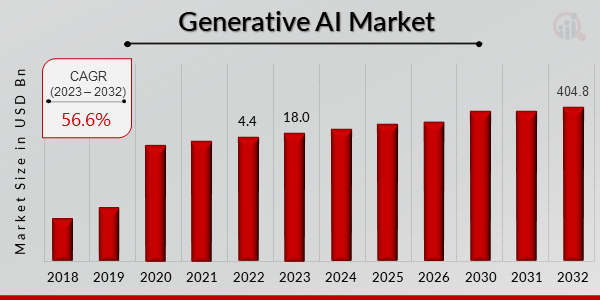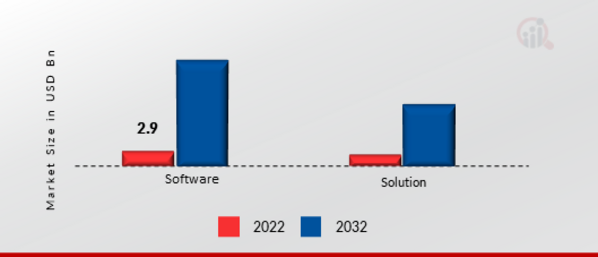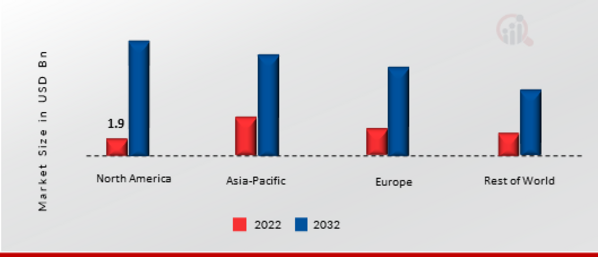Generative AI Market Overview
Generative AI Market Size was valued at USD 4.4 Billion in 2022. The Generative AI market industry is projected to grow from USD 18.0 Billion in 2023 to USD 404.8 Billion by 2032, exhibiting a compound annual growth rate (CAGR) of 56.6% during the forecast period (2023 - 2032). The generative AI market is experiencing rapid growth as businesses recognize its transformative potential. From virtual world creation to content generation and personalized user experiences, generative AI is revolutionizing industries by automating processes and delivering innovative solutions to meet the demands of a digitally-driven world.
The growing market for technology can help companies personalize customer interactions, unlock innovation through unconventional creativity, and better access enterprise data and knowledge to create value in new ways. Additionally, Generative AI can significantly reduce the manual effort required in areas such as order management and other administrative requests, all of which are key market drivers boosting the growth of the Generative AI market.
Figure1: Generative AI Market, 2019 - 2032 (USD Billion)

Source: Secondary Research, Primary Research, MRFR Database, and Analyst Review
Generative AI Market Trends
Increasing trend of virtual worlds in the metaverse and modernizing the workforce across the industry
In recent years, there has been a remarkable surge in the popularity of virtual worlds within the Metaverse. These immersive digital environments provide individuals with the opportunity to interact, collaborate, and engage in various activities in a virtual space. As more people embrace virtual reality technology, the trend of virtual worlds is on the rise, offering endless possibilities for entertainment, socialization, and even professional development.
One of the significant impacts of virtual worlds in the Metaverse is the modernization of the workforce across industries. As businesses adapt to the changing landscape, they are exploring innovative ways to leverage virtual worlds and enhance productivity. Companies are creating virtual offices, meeting spaces, and training simulations within these digital environments, enabling remote teams to collaborate seamlessly. Employees can participate in virtual conferences, attend training sessions, and even work on projects together, regardless of their physical locations.
Moreover, generative AI is playing a pivotal role in revolutionizing the workforce. With its ability to autonomously generate content, models, and solutions, generative AI is empowering businesses to streamline operations, automate processes, and enhance decision-making. From creating realistic virtual avatars to generating lifelike virtual environments, generative AI is transforming the Metaverse and enabling immersive experiences for users.
Furthermore, generative AI in the metaverse necessitates the use of a few human-created assets such as photos, sounds, or 3D models, followed by the use of computer randomness and processing capacity to generate equivalent original materials. Nvidia, for example, offered new metaverse technologies like as AR and VR for corporations in January 2023, along with a suite of generative AI tools such as omniverse portals. It debuted its Omniverse portals with generative AI for 3D and RTX, as well as upgrades to its Omniverse Enterprise platform and an early access programme for developers aiming to create avatars and virtual assistants.
Nvidia has introduced a new set of experimental generative AI tools for 3D artists, including Audio2Face, Audio2Gesture, and Audio2Emotion, which allow users to create 3D characters. These upgrades allow designers to generate facial expressions from audio files using Audio2Face, emotions using Audio2Emotion, and gestures using Audio2Gesture. Key players' strategic breakthroughs or developments are projected to boost the growth of the generative AI market.
Generative AI Market Insights
Generative AI Component Segment Insights
Based on Components, the Generative AI Market segmentation includes software and solution. The software segment held the majority share in 2022, contributing around ~65.3% to the market revenue. As the name suggests, software emerged as the dominant segment in the market, with the highest revenue share in 2022. The growing use of generative AI-based software, which provides benefits such as improved image resolution, reduced conversion time, improved performance, and quick output availability, is related to the segment's rise. Generative AI can be used to generate high-level architecture diagrams based on a set of inputs or specifications, and it can also be used to recommend appropriate technologies to use in a software system based on a set of requirements or constraints, such as performance, scalability, security, best practices, and trade-off analysis.
Figur e2: Generative AI Market, by Type, 2022 & 2032 (USD Billion)

Source: Secondary Research, Primary Research, MRFR Database, and Analyst Review
Generative AI Technology Segment Insights
Based on Technology, the Generative AI Market segmentation includes Generative Adversarial Networks (GANs), Transformers, Variational Auto-encoders (VAEs), Diffusion, and NeRFs. The Transformers segment held the majority share in 2022, contributing around ~37.5% to the market revenue. Transformers, in particular, have propelled much of the recent research and hype surrounding generative models. Transformers, a ground-breaking neural network that can analyze massive data sets at scale to construct large language models (LLMs), debuted in 2017. The models in OpenAI's Generative Pre-Trained Transformer series are among the largest and most powerful in this category, with one of the most recent, GPT-3, including 175 billion parameters.
Researchers introduced neural radiance fields (NeRFs) in 2020, a method for synthesizing 3D material from 2D photos. These fast evolving generative models are a work in progress, with researchers making changes that frequently result in significant advancements. Diffusion models excel in the image and video synthesis domains, while transformers excel in the text domain. GANs excel at adding plausible synthetic examples to tiny data sets.
Generative AI End Use Segment Insights
Based on the End Use, the Generative AI Market segmentation includes Large Language Model (LLM), Content Generation, Code Generation, Video Creation, and Image & Art Generation, and others. By End Use, the Large Language Model (LLM) segment holds the majority of the market share in 2022.
Large language models (LLMs) are a form of artificial intelligence (AI) system that works with language. LLM is the most specific term here, and it is frequently used by AI practitioners to denote to systems that operate with language. LLMs are commonly used in OpenAI's GPT-4, Google's PaLM, and Meta's LLaMA. Generative AI streamlines the video production process by providing more efficient and adaptable tools for creating high-quality video content. It can automate time-consuming processes such as video editing, special effects, animation, and so on.
AI technologies for video production, like picture generation, may make videos from zero and be used for video alteration, such as improving video resolution and completeness. Because of its ability to generate code without manual coding, generative AI can be used in software development. These methods reduce developers' time and effort in developing, testing, and repairing code by automating the software creation process.
Generative AI Industry Vertical Segment Insights
Based on the Industry Vertical, the Generative AI Market segmentation includes Manufacturing, IT & Telecommunication, Healthcare, Automotive & Transportation, Gaming, Academic and Research Institutions, BFSI, Aerospace & Defense, and Others. By Industry Vertical, the healthcare and manufacturing segment holds the majority of the market share in 2022. Generative AI serves a dual purpose in this industry. It has the potential to improve patient care first and foremost. Second, it has the potential to improve patient data privacy. To train and develop the Generative AI model, falsified and under-represented data is used. GANs, for example, can provide several views of an X-ray image to demonstrate potential.
Health care is expected to develop faster than any other industry, with a compound annual growth rate of 85% through 2027, reaching a total market size of $22 billion. Technology in MedTech can result in more efficient procedures, personalized client interactions, more innovation, and improved value. Generative AI offers significant prospects for MedTech companies to alter their business models. Because generative AI has so many possible uses, and because MedTech is a highly regulated field where people's lives are on the line, some companies may take a wait-and-see strategy. In-person visits to customers have been increasingly restricted for MedTech sales teams in recent years. As a result, several businesses have made investments in digital sales capabilities. Generative AI can help to accelerate those efforts by enabling mass personalization and adapting marketing messages to resonate more successfully with diverse client demographics, resulting in higher conversion rates.
By automating laborious coding, generative AI has also had an impact on the software development industry. Rather than totally coding the software, IT professionals may now swiftly design a solution by communicating what they are searching for to the AI model.
Generative AI Regional Insights
By Region, the study provides market insights into North America, Europe, Asia-Pacific, Middle East & Africa, and South America. In terms of revenue, North America held the largest share of 42.10% in the Generative AIs market in 2022 and is expected to continue its dominance throughout the forecast period. The rapid expansion of digital platforms especially during pandemic has facilitated the deployment of generative AI applications in numerous fields including drug discovery, contact tracing, remote healthcare misinformation detection and epidemiological modelling.
Emergence of work from home culture or remote working solution popularity Generative AI has played crucial role in facilitating collaboration, communication, virtual conferencing, remote work optimization as well as cybersecurity and data protection. For instance, Amazon Web Services, Inc. announced in June 2020 the inclusion of a new generative AI algorithm, Autoregressive Convolutional Neural Network (AR-CNN), to its AWS DeepComposer suite of products, allowing developers to digitally compose beautiful music.
Generative AI has experienced a substantial surge in demand from North America, particularly in the United States. The region's robust technological ecosystem, investment in AI research, and the presence of leading tech companies have contributed to this demand.
North America's strong emphasis on innovation and digital transformation has created a fertile ground for the adoption of generative AI technologies. Industries such as healthcare, finance, entertainment, and marketing have been at the forefront of leveraging generative AI to drive advancements and improve their operations.
In healthcare, generative AI is being used to expedite drug discovery, enhance medical imaging analysis, and assist in disease diagnosis. The finance sector has embraced generative AI for tasks like algorithmic trading, fraud detection, and risk assessment. In the entertainment industry, generative AI has revolutionized content creation, generating realistic images, videos, and music. Marketing and advertising have benefited from generative AI through personalized recommendations, customer segmentation, and creative content generation.
The demand for generative AI in North America is also fueled by the region's entrepreneurial spirit and start-up ecosystem. Numerous AI start-ups are focused on developing innovative generative AI applications to meet the specific needs of various industries.
Moreover, the increasing availability of large-scale datasets and advanced computing infrastructure in North America has provided the necessary resources to train and deploy complex generative AI models. The advent of cloud computing has further facilitated the accessibility and scalability of generative AI solutions.
Government initiatives and investments in AI research and development, such as the National Artificial Intelligence Research and Development Strategic Plan in the United States, have also contributed to the demand for generative AI technologies in North America. The United States continues to lead in AI conference and repository citations, but those advantages are diminishing. Nonetheless, American universities produce the majority of the world's large language and multimodal models (54% in 2022).
Figure3: GENERATIVE AI MARKET SIZE BY REGION 2022&2032

Source: Secondary Research, Primary Research, MRFR Database, and Analyst Review
Further, the key economies studied in the market report are the U.S., Canada, Germany, France, the UK, Italy, Spain, China, Japan, India, Australia, South Korea, and Brazil.
The presence of tech players in Europe and Asia-Pacific creates lucrative growth potential for the market in the area. Big IT giants, for example, are investing in generative AI businesses and technology. During the projection period, the Asia Pacific region is expected to develop at the highest CAGR. This is due to continuous mounting demand from end-user industries in emerging economies such as China and India, as well as the development of technology infrastructure and government initiatives.
India is set to capitalize on the promise of Artificial Intelligence (AI) to promote large-scale economic growth and development. India, with its big and diverse economy and large population, offers a unique chance to harness AI to benefit businesses, sectors, and society. AI spending has gradually increased since 2011, and it is expected to contribute considerably to the economy by 2035. AI start-ups in India have grown rapidly since 2011, and 88% of organizations polled intend to invest in AI-related technology. Recently, India ranked sixth in terms of AI investments from 2013 to 2022, totaling more than USD 7.73 billion over the last 10 years, with almost 40% of that received in 2022.
China on the other hand with government is interested in generative AI, since new money has been announced to assist COVID-19-related discoveries. Chinese tech businesses began working on their own AI universe with government support in January 2023. Local Chinese governments are also funding in various projects on their own through IDEA, a Chinese Communist Party-owned and sponsored research institute. Chinese tech firms have also shown out a few AI bots to the public, each with a twist tailored to the country's preferences and political situation.
Generative AI Key Market Players & Competitive Insights
With a strong presence across different verticals and geographies, the Generative AI market is highly competitive and partially dominated by established and pure-play vendors. Over 20 vendors cater to this market, and they continually innovate their solutions to meet the evolving needs of businesses by adopting new technologies to make business more effective. These vendors have a robust geographic footprint and partner ecosystem to cater to diverse customer segments. The Generative AI market is highly competitive, with many vendors offering similar products and services.
The major players in the market include Microsoft (US), IBM (US), Google (US), AWS (US), META (US), Adobe (US), OpenAI (US), Simplified (US), Insilico Medicine (Hong Kong), Genie AI (UK), Lightricks (Israel), Lumen5 (Canada), GIPHY (US), Dialpad (US), Persado (US), Codacy (Portugal), Paige.AI (US), Riffusion (US), Play.ht (India), Speechify (US), Media.io (France), Midjourney (US), FireFlies (US), Brandmark.io (Netherlands), Morphis Technologies (Portugal), Synthesia (UK), Mostly Al (Austria), Veesual (France), Deep AI (US), Galileo (US), Excel Formula Bot (Florida), JetBrains (Czech Republic), Character.AI (US), GFP-GAN (US), Fontjoy (Italy), Eleuther AI (US), Starry AI (US), and Magic Studio (US).
Google has two large language models: Palm (multimodal) and Bard (pure language). They are integrating their generative AI technology into their suite of workplace tools, putting it in the hands of millions of people right away. Microsoft and OpenAI are marching hand in hand. Microsoft, like Google, is incorporating generative AI technology into its products, but it benefits from the first-mover advantage and excitement generated by ChatGPT. Amazon has collaborated with Hugging Face, which has a number of open-source LLMs, to develop solutions. Amazon has also revealed plans for Titan, a pair of two AI models that create text and improve searches and customization, as well as Bedrock, which enables access to generative AI on the cloud via AWS. IBM has several foundation models with the capacity to fine-tune both its own and third-party models by infusing data, retraining, and employing the model.
The Generative AI Market is a partially consolidated market due to certain key players accounting for sizable market shares. Key players in the market are further opting for inorganic strategies such as acquisitions, mergers, and others to gain more BPS in the market and establish strong foothold globally. Additionally, immense competition from emerging start-ups has also made it difficult for key players to define their revenue model and add-ons with Generative AI services.
Key Companies in the Generative AI market include
- Microsoft (US)
- IBM (US)
- Google (US)
- AWS (US)
- META (US)
- Adobe (US)
- OpenAI (US)
- Simplified (US)
- Insilico Medicine (Hong Kong)
- Genie AI (UK)
- Lightricks (Israel)
- Lumen5 (Canada)
- GIPHY (US)
- Dialpad (US)
- Persado (US)
- Codacy (Portugal)
- AI (US)
- Riffusion (US)
- ht (India)
- Speechify (US)
- io (France)
- Midjourney (US)
- FireFlies (US)
- io (Netherlands)
- Morphis Technologies (Portugal)
- Synthesia (UK)
- Mostly Al (Austria)
- Veesual (France)
- Deep AI (US)
- Galileo (US)
- Excel Formula Bot (Florida)
- JetBrains (Czech Republic)
- AI (US)
- GFP-GAN (US)
- Fontjoy (Italy)
- Eleuther AI (US)
- Starry AI (US)
- Magic Studio (US)
Generative AI Industry Developments
- In February 2023, Google introduced the 'Bard' AI chatbot, a conversational AI that will compete with OpenAI's ChatGPT. It is believed to be a lightweight version of Google's LaMDA is capable of reacting to human inquiries and synthesizing information like ChatGPT. However, a problem in Bard was discovered within days after its release, in which the tool made a factual inaccuracy in one of its promotional films. Following this, Google's stock sank by 9%, and the company's market value dropped by roughly $100 billion.
- In February 2023, to encourage more people to use search and the web, Microsoft unveiled the AI-powered Bing search engine and Edge browser as a preview as an AI co-pilot for the web. Users asked Bing queries, and it responded directly in chat rather than with links to websites. Users who had access to this capability were curious to have lengthy discussions with the search engine, which subsequently became demented and began expressing emotions such as love and wrath.
Generative AI Market Segmentation
Generative AI Component Outlook
Generative AI Technology Outlook
- Generative Adversarial Networks (GANs)
- Transformers
- Variational Auto-encoders (VAEs)
- Diffusion
- NeRFs
Generative AI End Use Outlook
- Large Language Model (LLM)
- Content Generation
- Code Generation
- Video Creation
- Image and Art Generation
- Others
Generative AI Industry Vertical Outlook
- Manufacturing
- IT & Telecommunication
- Healthcare
- Automotive & Transportation
- Gaming
- Academic and Research Institutions
- BFSI
- Aerospace & Defence
- Others
Generative AI Regional Outlook
-
North America
-
US
-
Canada
-
Europe
-
Germany
-
France
-
UK
-
Italy
-
Spain
-
Rest of Europe
-
Asia-Pacific
-
China
-
Japan
-
India
-
Australia
-
South Korea
-
Australia
-
Rest of Asia-Pacific
-
Rest of the World
-
Middle East & Africa
-
South America
| Report Attribute/Metric |
Details |
| Market Size2022 |
USD 4.4 Billion |
| Market Size 2023 |
USD 7.2 Billion |
| Market Size 2032 |
USD 404.8 Billion |
| Compound Annual Growth Rate (CAGR) |
56.6 % (2023-2032) |
| Base Year |
2022 |
| Market Forecast Period |
2023-2032 |
| Historical Data |
2019- 2022 |
| Market Forecast Units |
Value (USD Billion) |
| Report Coverage |
Revenue Forecast, Market Competitive Landscape, Growth Factors, and Trends |
| Segments Covered |
Component, Technology, End Use, Industry Vertical, and Region |
| Geographies Covered |
Europe, North America, Asia-Pacific, Middle East & Africa, and South America |
| Countries Covered |
The U.S, Germany, Canada, U.K., Italy, France, Spain, Japan, China, Australia, India, South Korea, and Brazil |
| Key Companies Profiled |
Microsoft (US), IBM (US), Google (US), AWS (US), META (US), Adobe (US), OpenAI (US), Simplified (US), Insilico Medicine (Hong Kong), Genie AI (UK), Lightricks (Israel), Lumen5 (Canada), GIPHY (US), Dialpad (US), Persado (US), Codacy (Portugal), Paige.AI (US), Riffusion (US), Play.ht (India), Speechify (US), Media.io (France), Midjourney (US), FireFlies (US), Brandmark.io (Netherlands), Morphis Technologies (Portugal), Synthesia (UK), Mostly Al (Austria), Veesual (France), Deep AI (US), Galileo (US), Excel Formula Bot (Florida), JetBrains (Czech Republic), Character.AI (US), GFP-GAN (US), Fontjoy (Italy), Eleuther AI (US), Starry AI (US), and Magic Studio (US) |
| Key Market Opportunities |
Rising acceptance of data-centric production approaches- Data-centric design has many advantages for industrial enterprises, including increased revenue, lower costs, improved productivity, and better risk management. |
| Key Market Dynamics |
Expanding the use of machine learning across business verticals - Machine learning and its subsets can be applied to a wide range of problems, jobs, and applications. Providing condensed versions of discussions, articles, emails, and web pages |
Generative AI Market Highlights:
Frequently Asked Questions (FAQ) :
The Generative AI Market size is expected to be valued at USD 4.4 Billion in 2022.
The global market is projected to grow at a CAGR of 56.6% during the forecast period, 2023-2032.
North America had the largest share of the global market.
The key players in the market are Microsoft (US), IBM (US), Google (US), AWS (US), META (US), Adobe (US), OpenAI (US), Simplified (US), Insilico Medicine (Hong Kong), Genie AI (UK), Lightricks (Israel), Lumen5 (Canada), GIPHY (US), Dialpad (US), Persado (US), Codacy (Portugal), Paige.AI (US), Riffusion (US), Play.ht (India), Speechify (US), Media.io (France), Midjourney (US), FireFlies (US), Brandmark.io (Netherlands), Morphis Technologies (Portugal), Synthesia (UK), Mostly Al (Austria), Veesual (France), Deep AI (US), Galileo (US), Excel Formula Bot (Florida), JetBrains (Czech Republic), Character.AI (US), GFP-GAN (US), Fontjoy (Italy), Eleuther AI (US), Starry AI (US), and Magic Studio (US).
The Software Component category dominated the market in 2022.




























